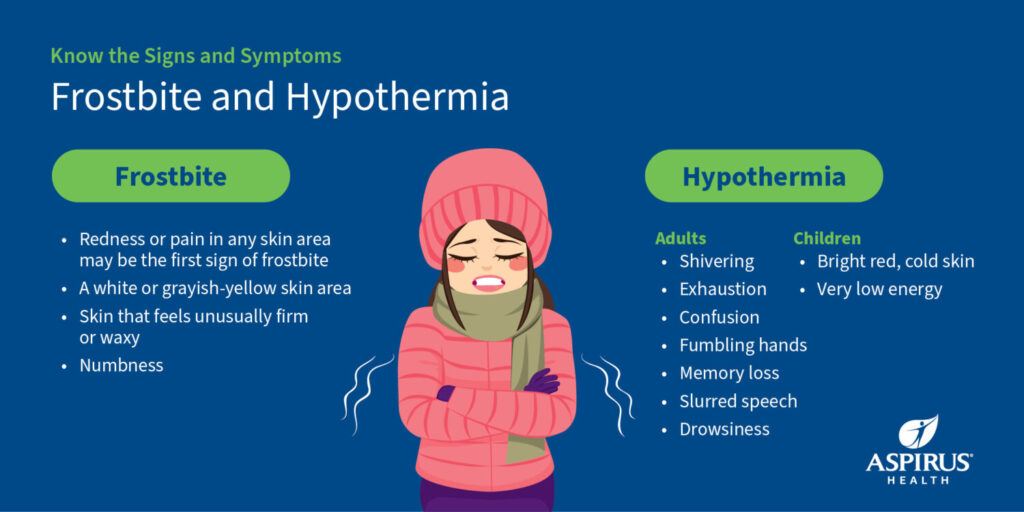
Cold winters are an inevitable part of life in the upper Midwest, but too much exposure to extremely cold air has the potential to be life-threatening.
“In cold temperatures, the body begins to lose heat faster than it can be produced, which can lead to cold-related illnesses such as hypothermia or frostbite,” said Andrew Stoltze, MD, Aspirus Emergency Room Physician. “Being cold is uncomfortable at best, but it can also become dangerous.”
Ready Wisconsin and the Centers for Disease Control and Prevention (CDC) suggest learning the signs of, and basic treatments for, these conditions:
Hypothermia is an unusually low body temperature.
• Signs: Shivering, exhaustion, confusion, fumbling hands, memory loss, slurred speech, or drowsiness.
• Actions: Hypothermia is a medical emergency. If you notice any of the above signs, take the person’s temperature. If it is below 95° F, get medical attention immediately. If you are not able to get medical help right away, try to warm the person up. Go to a warm room. Warm the center of the body first—chest, neck, head, and groin. Keep dry and wrapped up in warm blankets, including the head and neck.
Frostbite causes loss of feeling and color around the face, fingers, and toes.
• Signs: Numbness, white or grayish-yellow skin, firm or waxy skin.
• Actions: Seek medical attention immediately. If a person shows signs of frostbite, but no signs of hypothermia, and immediate medical care is not available, go to a warm room. Soak in warm water. Use body heat to warm. Do not massage or use a heating pad.
According to CDC, anyone can suffer from cold-related health issues, but some people are at greater risk than others. They include older adults, young children, those who are sick, and those without adequate shelter. “Being prepared is your best defense against extremely cold weather,” Dr. Stoltze said.
The Wisconsin Department of Health Services (DHS) offers these seven tips to stay warm and prevent cold-related illnesses this winter:
- Stay inside. When possible, stay indoors. If you must go outside, dress in loose-fitting layers and cover up as much of your body as you can. The more skin that’s exposed, the faster you can get frostbite. Wear a hat, mittens, and boots, as well as a scarf to cover your mouth and face.
- Create a home emergency kit. Stock up on items such as food and water, first aid kit, cell phone and charger, flashlight and batteries, any necessary medications, weather radio, and extra clothes.
- Winterize your car. Create a second emergency kit for your car, but with a few extra items. This kit should include blankets, snacks and water, a shovel, jumper cables, and sand. Always keep your gas tank at least half-full.
- Communicate if you leave. If heading out, especially on an outdoor excursion, tell relatives and friends where you are going and when you expect to return.
- Check on your friends, family, and neighbors. It’s critical to check on loved ones and neighbors during extreme cold, especially those who are elderly. Make sure they are stocked up with the supplies they need and taking measures to stay warm.
- Do not ignore shivering. It’s an important first sign that the body is losing heat. Persistent shivering is a signal to return indoors.
- Limit outdoor time for pets. Extreme cold is dangerous for animals too.
Anyone who is exposed to cold temperatures and recognizes any signs of cold-related illnesses should seek medical care as soon as possible. To find an Aspirus facility near you, visit https://www.aspirus.org/find-a-location.
